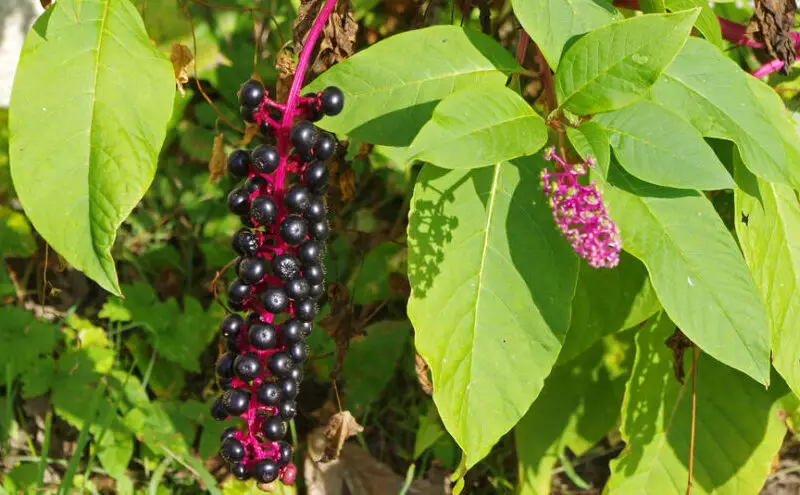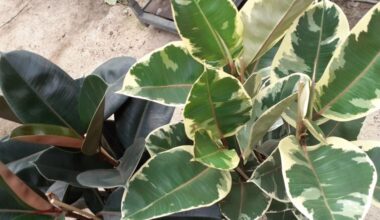The phytolacca americana, or American grape, is a very pretty invasive plant, but also very toxic. It is this plant which resembles very strongly the traditional grapes, it is recommended to pull it up as soon as it appears. Most of the time, it’s the plant we’re thinking about when we’re looking for a plant that looks like Grape Vines. There are 4 other plants that we present to you at the end of the article.
Its large green leaves, its large reddish stem and its small green then dark purple berries, grouped in clusters, give Phytolacca americana a beautiful decorative aspect. Many inhabitants let thus grow in their gardens this plant nicknamed American grape. A mistake, because it is invasive and toxic.
We explain how to get rid of it, as well as how to cultivate it, if you really want to get rid of it.
Contents
How to behave with Phytolacca
To fight against phytolaque, uprooting is the safest method. It varies according to the stages of development. Depending on the nature of the soil, the plant can be pulled up by hand without the root breaking, but in most cases it is better to be equipped with a pick or a triandine to facilitate extraction and prevent the stem from breaking at the collar. Beware especially of grapes that propagate seeds.
Mowing can also be used for different purposes: to exhaust the plant in order to eradicate it, to delay the development of a clump, to prevent fruiting, to delay the development of a clump, while waiting to be uprooted.
Caning, which consists of hitting the plant with a stick or a wooden tool handle, is a practice used during operations to clear young plants from trees that are still sensitive to competition. The principle is to give a sharp blow so that the stem is well sectioned, and not crushed by bending. If the stem is not cut, it may continue to grow and straighten.
Fruit clusters can also be harvested. These “harvests” must take place in July-August, to prevent fruiting and thus deprive the plant of reproduction. The fruit bunches should be cut with pruning shears and collected in thick garbage bags, which will be incinerated with the household waste. However, if the intervention takes place too late, it is possible that some of the clusters already formed have been consumed by the birds and the seeds have already been disseminated.
Naturally, avoid the use of herbicides, which are harmful to health and less effective than uprooting. Especially since they indiscriminately kill other plants in the garden and poison auxiliary animals.
Beware of the invasion!
The American grape reproduces very easily through its seeds, which have a very long life span. The berries are very appreciated by birds, and the latter have greatly contributed to the spread of the species, on the edge of forests, in clearings or on the sides of roads.
Beware of its toxicity!
Virginia grapes are toxic by their roots, leaves and fruit. If in humans the consequences are not fatal (digestive disorders more or less important), it is not the same for herbivores (especially for cows and horses).
It seems, however, that the young leaves are edible (one of the other names of the plant is the Sweet Spinach from Martinique), but by taking certain precautions of preparation (boiled several times, and evacuation of the cooking water).
Can one cultivate this plant which resembles grapes?
Given its invasive character, it seems unwise to want to install the Virginia grape in one’s garden. By removing the berries as they ripen, you can enjoy its originality without the risk of invading the neighborhood. But remain vigilant!
His needs? They are few and far between; a fresh, humus-rich substrate, and that’s all there is to it.
Ideal soil and exposure for Phytolacca
The American grape is cultivated in full sun or half-shade in fertile and fresh soil, ideally sandy.
Date of sowing and planting of the American Grape
The sowing is done spontaneously especially since the seeds spread by birds have an extremely long germination time. Taking into account its invasive character, the plant should not be sown.
Phytolacca care and cultivation advice
It is best to eradicate it with a pickaxe if it grows in your garden, since everything possible is being done to prevent it from spreading today. If you wish to keep a foot of it, cut off the fruit bunches before they are ripe to prevent birds from eating them and contributing to its expansion.
Diseases, pests and parasites of the American grape
The American grape can be a carrier of the mosaic virus.
Use of the American grape
You will find in homeopathy Phytolacca decandra, in granules or mother tincture, used against painful periods, painful breasts when breastfeeding, rheumatic pain, angina.
4 plants that look like grapes
Generally, when we think of a plant that looks like the reasons, we talk about phytolacca, but there are some others:
- Porcelain Berry
- Boston ivy
- Crimson Glory Vine
- Grape Ivy
Summary
Phytolacca americana is a plant that produces its effect in a garden but is also considered very invasive… A beautiful but toxic plant
It is a plant considered invasive. If you decide to adopt it (because it produces its small effect!), restrict yourself to growing it in pots and also make sure to remove the seeds that have reached maturity!
Pull out any unwanted new shoots! It has become naturalized in many regions of France, where it has invaded many forests.









